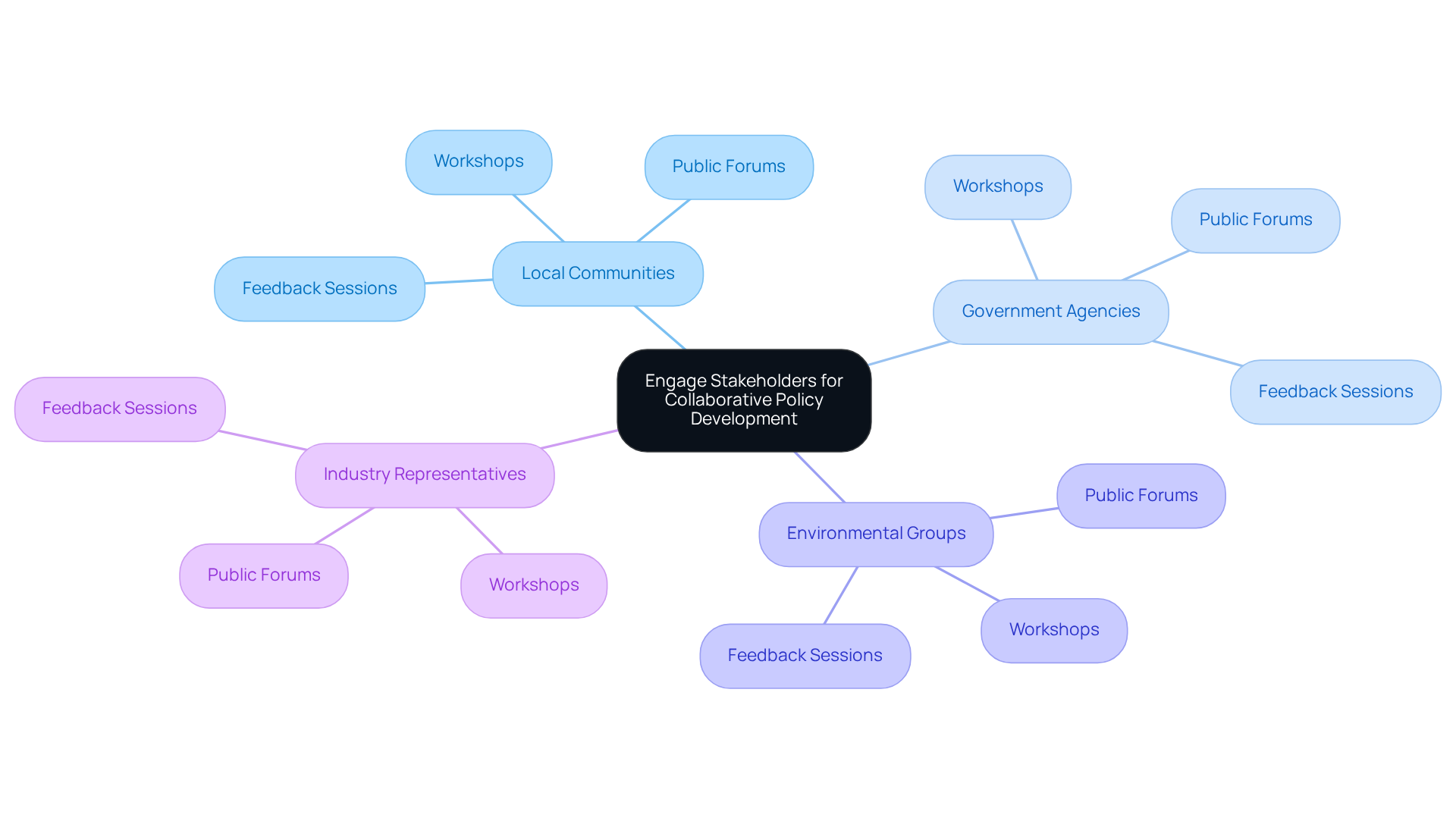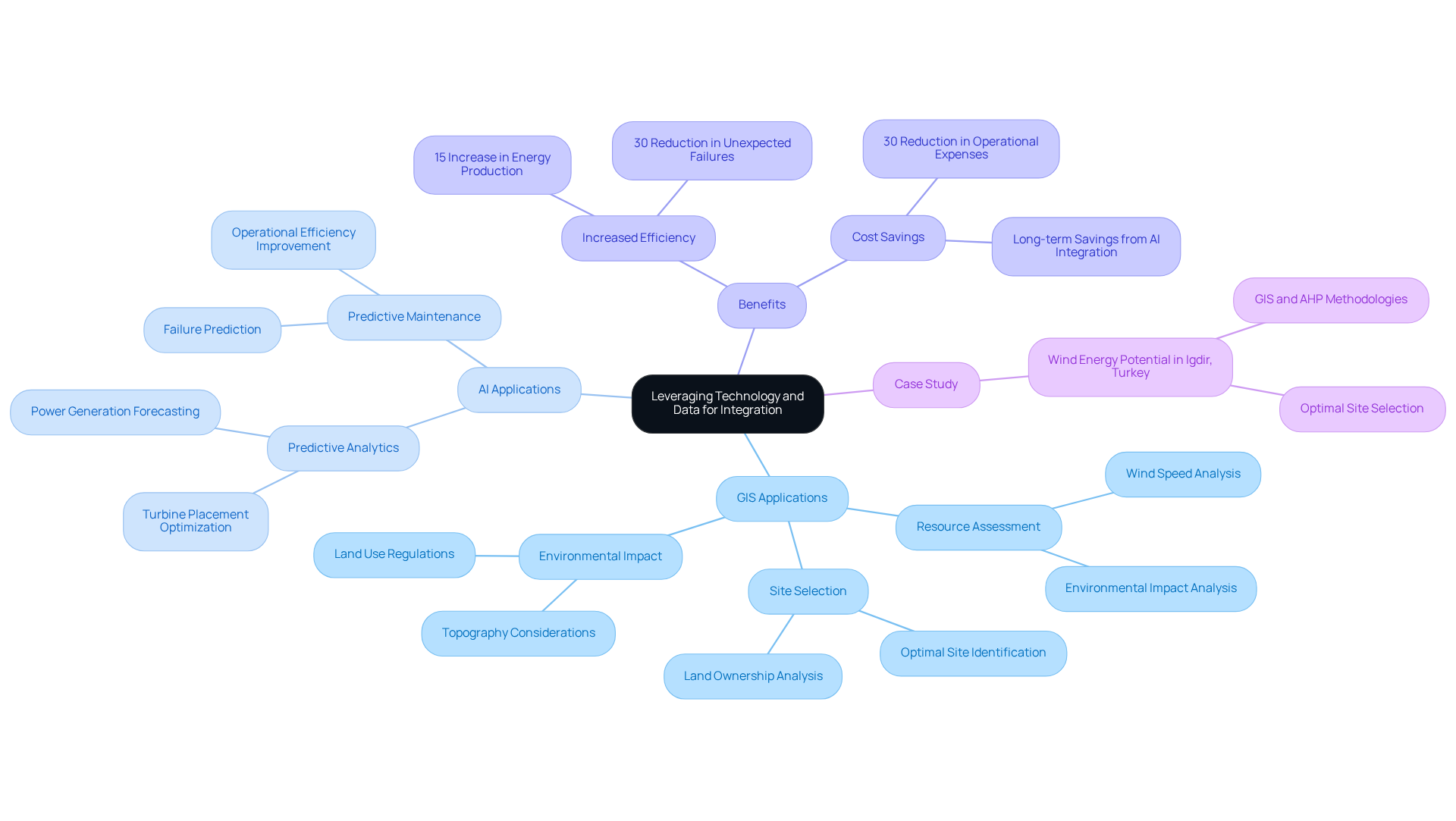Overview
Successful integration of regional wind policy hinges on three pivotal strategies:
- Aligning policies with local needs
- Engaging stakeholders for collaborative development
- Leveraging technology and data
Understanding regional contexts is essential, as it fosters community involvement and stakeholder collaboration. Moreover, the utilization of advanced technologies, such as GIS and AI, significantly enhances decision-making and operational efficiency in renewable energy initiatives. By implementing these strategies, stakeholders can navigate the complexities of policy integration effectively.
Introduction
The urgency for renewable energy integration has reached a critical juncture, with the incorporation of wind policies at the regional level presenting a multifaceted challenge. By aligning these policies with local needs and actively engaging stakeholders, regions can unlock the full potential of wind energy while addressing community concerns. However, how can policymakers adeptly navigate the complex landscape of regulations, technology, and public sentiment to ensure effective implementation? This article explores three essential strategies that can facilitate successful regional wind policy integration, offering insights poised to transform local energy landscapes.
Align Policies with Regional Needs and Conditions
The successful incorporation of renewable energy initiatives hinges on their alignment with the unique requirements and circumstances of each area. This necessitates comprehensive assessments of local resources, environmental impacts, and community sentiments. For example, regions endowed with significant wind potential but facing limited public support may benefit from strategies that prioritize community involvement initiatives and offer incentives for local participants. Understanding the regulatory environment and current land utilization trends is paramount for devising strategies that streamline approvals and minimize conflicts.
A compelling case study from the Midwest illustrates that localized regulatory adjustments can yield an impressive 30% increase in approvals by effectively addressing community concerns and adhering to environmental regulations. Moreover, leveraging Harbinger Land's expertise in negotiating and acquiring leases and easements, particularly through GIS modeling services, can facilitate efficient easements that save time and resources in the land acquisition process.
As Piotr Bojek, lead author, aptly stated, "Efforts should be focused on facilitating permitting, gaining public support, supporting the identification of suitable sites, decreasing costs, and reducing project development timelines." This underscores the critical importance of community involvement and effective land rights acquisition in enhancing the success of renewable energy strategies.

Engage Stakeholders for Collaborative Policy Development
Effective stakeholder involvement is a cornerstone of successful regional wind policy integration. Identifying and engaging key stakeholders—local communities, government agencies, environmental groups, and industry representatives—at the outset is essential. Regular workshops, public forums, and feedback sessions facilitate open dialogue and collaboration.
Consider a recent initiative in California, which effectively incorporated stakeholder input into its regulatory framework. This led to a comprehensive strategy that addressed environmental concerns while promoting economic benefits. By cultivating a sense of ownership among stakeholders, guidelines are more likely to gain support and be executed successfully.

Leverage Technology and Data for Effective Integration
The effective incorporation of renewable power policies hinges on the utilization of technology and information. Advanced tools, such as Geographic Information Systems (GIS) and AI-powered analytics, provide invaluable insights into site selection, resource assessment, and environmental impact analysis.
For instance, GIS mapping plays a pivotal role in identifying optimal sites for energy farms by analyzing airflow patterns, land use, and proximity to infrastructure. As Kevin Gildea from NextEra Energy highlights, GIS technology enhances understanding of land ownership and topography, which are essential for effective site selection.
Furthermore, data-informed decision-making significantly improves planning and execution. A recent study demonstrated this by employing predictive analytics to forecast power generation and optimize turbine placement, resulting in a remarkable 15% increase in efficiency. Additionally, AI-driven predictive maintenance has achieved a notable 30% reduction in unexpected turbine failures, underscoring the operational advantages of AI analytics in renewable projects.
With AI-enhanced forecasting reaching a 90% accuracy rate in predicting power production, these technologies are instrumental in optimizing output. Nevertheless, it is crucial to recognize the common pitfalls in implementing these technologies, particularly the initial high costs associated with AI integration.
By embracing these technologies, policymakers can craft more efficient and adaptive strategies for harnessing power in the context of regional wind policy integration. A case study assessing wind energy potential in Igdir, Turkey, exemplifies the successful application of GIS and AI methodologies in real-world scenarios, further reinforcing the credibility of these approaches.

Conclusion
The integration of regional wind policies is essential for ensuring that renewable energy initiatives are specifically tailored to the unique needs and conditions of each area. By aligning policies with local resources, community sentiments, and environmental regulations, stakeholders can cultivate a more effective and supportive environment for wind energy development.
Engaging stakeholders through collaborative policy development is a key strategy, fostering ownership and support for initiatives. Additionally, leveraging advanced technologies and data analytics is crucial for optimizing site selection and enhancing operational efficiency. These approaches address community concerns while ensuring that the integration of wind energy is economically and environmentally sustainable.
Ultimately, the success of regional wind policy integration hinges on a holistic approach that combines community involvement, targeted policy adjustments, and innovative technology. As the demand for renewable energy continues to escalate, adopting these strategies is vital for overcoming challenges and maximizing the potential of wind energy. Embracing this comprehensive methodology can lead to resilient, adaptive, and successful wind energy policies that benefit both local communities and the broader environment.
Frequently Asked Questions
Why is it important to align renewable energy initiatives with regional needs?
Aligning renewable energy initiatives with regional needs is crucial because it ensures that the unique requirements and circumstances of each area are considered, leading to more effective and accepted projects.
What factors should be assessed for successful renewable energy initiatives?
Successful renewable energy initiatives require comprehensive assessments of local resources, environmental impacts, and community sentiments.
How can regions with significant wind potential but limited public support improve their initiatives?
These regions can improve their initiatives by prioritizing community involvement initiatives and offering incentives for local participants to gain public support.
What role does understanding the regulatory environment play in renewable energy strategies?
Understanding the regulatory environment and current land utilization trends is essential for devising strategies that streamline approvals and minimize conflicts in renewable energy projects.
What is an example of a successful strategy in the Midwest regarding renewable energy initiatives?
A case study from the Midwest showed that localized regulatory adjustments could lead to a 30% increase in approvals by effectively addressing community concerns and adhering to environmental regulations.
How can Harbinger Land assist in the land acquisition process for renewable energy projects?
Harbinger Land can facilitate efficient easements and save time and resources in the land acquisition process by leveraging their expertise in negotiating and acquiring leases and easements, particularly through GIS modeling services.
What key aspects should be focused on to enhance the success of renewable energy strategies?
Efforts should focus on facilitating permitting, gaining public support, identifying suitable sites, decreasing costs, and reducing project development timelines to enhance the success of renewable energy strategies.
List of Sources
- Align Policies with Regional Needs and Conditions
- Wind - IEA (https://iea.org/energy-system/renewables/wind)
- Electricity generation from wind - U.S. Energy Information Administration (EIA) (https://eia.gov/energyexplained/wind/electricity-generation-from-wind.php)
- Wind Market Reports: 2023 Edition (https://energy.gov/eere/wind/wind-market-reports-2023-edition)
- Topic: Wind power in the U.S. (https://statista.com/topics/1054/wind-power-market)
- Wind Data and Tools | Wind Research | NREL (https://nrel.gov/wind/data-tools.html)
- Engage Stakeholders for Collaborative Policy Development
- Resource Mix (https://iso-ne.com/about/key-stats/resource-mix)
- Wind Power Facts and Statistics | ACP (https://cleanpower.org/facts/wind-power)
- Wind - IEA (https://iea.org/energy-system/renewables/wind)
- Leverage Technology and Data for Effective Integration
- Speeding Up Wind Energy Growth (https://esri.com/about/newsroom/publications/wherenext/wind-energy-lifecycle)
- Assessment of Wind Energy Potential and Optimal Site Selection for Wind Energy Plant Installations in Igdir/Turkey (https://mdpi.com/2071-1050/16/20/8775)
- AI and Machine Learning in Wind Energy Optimization (https://vocal.media/writers/ai-and-machine-learning-in-wind-energy-optimization)
- Wind farm site selection using geographic information system and fuzzy decision making model (https://sciencedirect.com/science/article/pii/S0957417424016397)
- Wind power plant site selection problem solution using GIS and resource assessment and analysis of wind energy potential by estimating Weibull distribution function for sustainable energy production: The case of Bitlis/Turkey (https://sciencedirect.com/science/article/pii/S2211467X2400261X)




